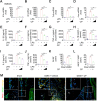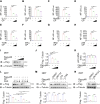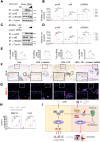Carpaine ameliorates synovial inflammation by promoting p65 degradation and inhibiting the NF-κB signalling pathway
- PMID: 40237708
- PMCID: PMC12002088
- DOI: 10.1302/2046-3758.144.BJR-2024-0327.R1
Carpaine ameliorates synovial inflammation by promoting p65 degradation and inhibiting the NF-κB signalling pathway
Abstract
Aims: Osteoarthritis (OA) is a chronic and debilitating joint disease. Despite its prevalence, especially in ageing and obese populations, effective treatments targeting the molecular mechanisms of OA are limited. This study aimed to investigate the role of carpaine (CP), a major alkaloid from the Carica papaya leaf, in inhibiting articular cartilage destruction and synovitis during OA progression, and to elucidate the underlying molecular mechanisms.
Methods: CP (purity > 98%) was dissolved in dimethyl sulfoxide (DMSO). Various antibodies and reagents were sourced from Sigma-Aldrich, Abcam, and other suppliers. Peritoneal macrophages (pMACs) were cultured in Dulbecco's Modified Eagle Medium (DMEM) and treated with CP to assess its effects on inflammatory cytokine production and nuclear factor-kappa B (NF-κB) signalling. A total of 40 ten-week-old male C57/BL6 mice underwent destabilization of the medial meniscus (DMM) surgery to induce OA. Post-surgery, mice were treated with CP (0.5 or 3 mg/kg) or vehicle via intra-articular injections for up to ten weeks. Cartilage degradation and synovitis were evaluated using Safranin O, Fast Green staining, haematoxylin and eosin (H&E) staining, immunohistochemistry, and quantitative polymerase chain reaction (PCR).
Results: CP treatment significantly reduced cartilage degeneration and maintained hyaline cartilage thickness compared to the vehicle group. Indicators of cartilage degeneration, such as collagen X (Col X) and matrix metallopeptidase 13 (MMP13), were markedly decreased in the CP-treated group. CP-treated mice exhibited significantly lower synovitis scores at both five and ten weeks post-DMM surgery. CP prominently decreased the production of proinflammatory cytokines (interleukin (IL)-1β, IL-6) in M1 polarized macrophages both in vitro and in vivo. CP impeded NF-κB signalling by promoting p65 degradation through the E3 ubiquitin ligase LRSAM1. The defensive effect of CP was reversed by Lrsam1 small interfering RNA (siRNA), confirming the role of LRSAM1 in CP-mediated NF-κB inhibition.
Conclusion: CP acts as a 'physiological brake' on NF-κB activation, thereby mitigating synovial inflammation and cartilage destruction in OA. These findings suggest that targeting synovitis via CP could be a promising therapeutic strategy for OA.
© 2025 Zhang et al.
Conflict of interest statement
H. Zhang reports funding from the state-funded postdoctoral researcher program of Southern Medical University (No. GZC20231062 (CN)), related to this study. D. Cai reports funding from the National Natural Science Foundation of China (82172491), related to this study. C. Zeng reports funding from the Natural Science Foundation of Guangdong Province (2022A1515011101 and 2024A1515011231), related to this study.
Figures






Similar articles
-
Teriparatide ameliorates articular cartilage degradation and aberrant subchondral bone remodeling in DMM mice.J Orthop Translat. 2022 Dec 7;38:241-255. doi: 10.1016/j.jot.2022.10.015. eCollection 2023 Jan. J Orthop Translat. 2022. PMID: 36514714 Free PMC article.
-
Decreased Peli1 expression attenuates osteoarthritis by protecting chondrocytes and inhibiting M1-polarization of macrophages.Bone Joint Res. 2023 Feb;12(2):121-132. doi: 10.1302/2046-3758.122.BJR-2022-0214.R1. Bone Joint Res. 2023. PMID: 36718653 Free PMC article.
-
Fargesin ameliorates osteoarthritis via macrophage reprogramming by downregulating MAPK and NF-κB pathways.Arthritis Res Ther. 2021 May 14;23(1):142. doi: 10.1186/s13075-021-02512-z. Arthritis Res Ther. 2021. PMID: 33990219 Free PMC article.
-
Loganin ameliorates cartilage degeneration and osteoarthritis development in an osteoarthritis mouse model through inhibition of NF-κB activity and pyroptosis in chondrocytes.J Ethnopharmacol. 2020 Jan 30;247:112261. doi: 10.1016/j.jep.2019.112261. Epub 2019 Sep 29. J Ethnopharmacol. 2020. PMID: 31577939
-
Alpha-Mangostin protects rat articular chondrocytes against IL-1β-induced inflammation and slows the progression of osteoarthritis in a rat model.Int Immunopharmacol. 2017 Nov;52:34-43. doi: 10.1016/j.intimp.2017.08.010. Epub 2017 Aug 31. Int Immunopharmacol. 2017. PMID: 28858724
References
LinkOut - more resources
Full Text Sources
Miscellaneous

